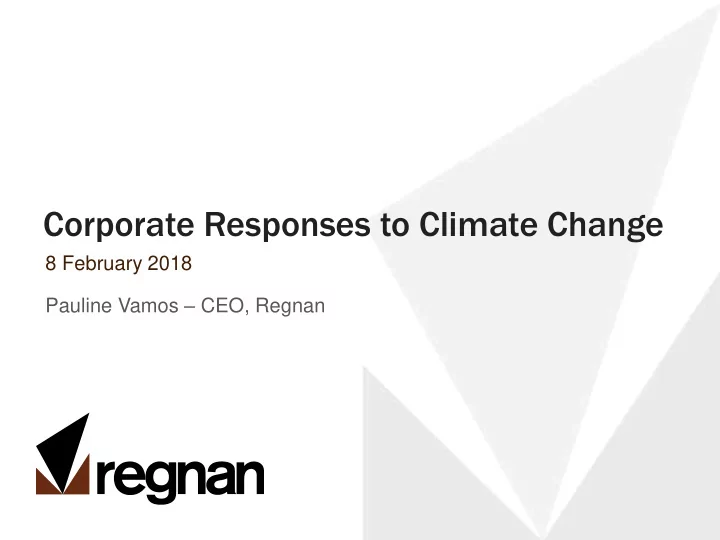

Corporate Responses to Climate Change 8 February 2018 Pauline Vamos – CEO, Regnan
Drivers of corporate responses
Pressure from investors concerned with climate change Stewardship Systemic risk borne within portfolios / stranded asset risk caused by climate change Superannuation funds are increasingly concerned about the general quality of life provided to members as they retire
Pressure from investors concerned with climate change Increased focus on fiduciary duty Globally Principles for Responsible Investment Task Force on Climate-related Financial Disclosures Landmark speech by Governor of the Bank of England, Mark Carney In Australia Legal opinion published by Noel Hutley SC Landmark speech by APRA’s Geoff Summerhayes
Pressure from investors concerned with climate change Member and community expectations Divestment Market Forces campaigns (such as Medibank) University endowment funds campaigns High profile divestments e.g. NYC Pension Fund, Norwegian Sovereign Wealth Fund Shareholder resolutions Exxon Santos Origin Energy BHP
Investor responses Values vs value – shaping responses Values Value How can we How will How does my limit climate change, as climate investment well as its change activity financial affect my contribute to impacts, investments climate through better change? or portfolio? management of its risks?
Investor responses Can be viewed as a continuum – where investors sit influences actions they take Values Value Integration of Wholesale divestment environmental – e.g. of fossil fuel information into stocks investment decision making Carbon footprinting Company engagement Shareholder Selected divestment – resolutions e.g. of energy generators demonstrating poor transition plans
Opportunities It’s not just about risk Upside Seeking alpha Emerging technologies e.g. renewables Emerging financial instruments e.g. green bonds Differentiation for funds Fund members’ expectations are changing e.g. demand from millennials and women
The role of advocacy Involvement in public dialogues Shaping policy Formal submissions Policy-focused publications Awareness raising Through the media Among fund members Investor communiques E.g. Larry Fink letters to CEOs
Company responses
Physical impacts We’re already seeing physical impacts affect earnings and ‘business as usual’ Insurance Increasing frequency of extreme weather events have put pressure on margins Gaming Tatts Group has experienced declining revenue associated with horse race cancellations due to bad weather Retail Myer has suffered losses as a changing climate has impacted winter apparel sales
Physical impacts We’re already seeing physical impacts affect earnings and ‘business as usual’ Mining Rio Tinto lost production worth more than $1.2bn due to an intense La Niña event impacting the Pilbara during the 2016/17 wet season Health care Ansell and Blackmores have had to diversify their supply chains for latex and krill oil respectively – used in key products – due to changing climates
Some examples of company responses Adapting to a changing climate Aurizon – Australia’s largest rail freight operator – has been adapting to increasing severity and frequency of extreme weather events Source: Aurizon Sustainability Report 2017
Some examples of company responses Adapting to a changing climate Infrastructure Brisbane Airport – Anticipating sea level rise and storm surges Property Sector Barangaroo South – Planning for extreme heat, rain and wind, as well as energy and water restrictions Banking NAB – Considering climate change impacts in assessment of default risks in loans to the dairy sector
Gaps and areas for improvement
Disclosure Scenario analysis – relevant to investors and companies alike Quality is patchy Very little is done on physical risks Many readers aren’t able to adequately assess disclosures We’d like to see scenario analysis disclosures that: Look at all risks Are clear about the assumptions made – and processes for if and when they change Make clear how decision points are built into time horizon When to revisit action/trigger points? At what point is a scenario considered to be playing out or not?
Disclosure Relevant to investors and companies alike There’s a lot of scope for upskilling both in the way climate disclosures are produced and the way they are assessed Investors will increasingly be demanding quality disclosures from companies: As their capacity to understand disclosures improves As they move to assess risks within their own portfolios
Company-Investor engagement Increased activity, but skills gaps remain More activity focused specifically on climate change Shareholder resolutions Company-investor engagement meetings Emphasis moving from emissions intensity to transition Adaption requires more attention As disclosure improves, so too will quality and impact of engagement
Quality is important If corporate responses are to positively impact climate change Responses need to better consider physical risks and adaptation Need efforts to be focused on those actions that will have the most impact Academia well positioned to improve quality of responses – research/analysis can inform corporates and identify areas of most concern Companies need to be held to account Whether that be investors (and financiers) interrogating company disclosures or company boards holding management to account Not possible unless investors and boards have the skills to do so – we need to urgently close this skills gap
Thank You
Recommend
More recommend